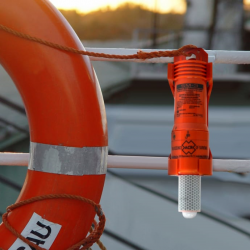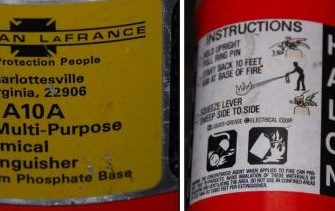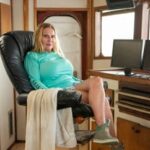Tag Archives: Marine safety equipment
NTSB Issues Safety Alert on Personal Locator Devices for Mariners
 A new safety alert issued by the National Transportation Safety Board (NTSB) to provide each crewmember with a personal locator device. These devices improve a mariner’s chance of rescue during an emergency. During an emergency at sea, a mariner’s chance of survival decreases if search and rescue cannot quickly and accurately identify their location. Personal locator devices, such as personal locator beacons (PLB) or satellite emergency notification devices (SEND), can accurately pinpoint a person’s location. NTSB investigations found that currently available personal locator beacons provide a location accuracy of about 300 feet and a nearly instant search and rescue notification when activated. more, <<click to read<<17:24
A new safety alert issued by the National Transportation Safety Board (NTSB) to provide each crewmember with a personal locator device. These devices improve a mariner’s chance of rescue during an emergency. During an emergency at sea, a mariner’s chance of survival decreases if search and rescue cannot quickly and accurately identify their location. Personal locator devices, such as personal locator beacons (PLB) or satellite emergency notification devices (SEND), can accurately pinpoint a person’s location. NTSB investigations found that currently available personal locator beacons provide a location accuracy of about 300 feet and a nearly instant search and rescue notification when activated. more, <<click to read<<17:24

The Maine Man, Wayne Hamilton
Wayne Hamilton has built Hamilton Marine into a successful accessories business by making sure he takes care of his customers.,, He had gotten his mother and mother-in-law to co-sign separate $10,000 business loans, and in 1977, Hamilton opened a wholesale account with Manset Marine in Rockland, Maine. He started out selling marine equipment from his garage. Every Wednesday, he’d load up his mustard-colored Chevy Blazer and snowmobile trailer with marine equipment and go to the commercial fishing co-ops to sell gear to the commercial anglers. One new piece of equipment he had was survival suits. They weren’t yet required on commercial vessels, and the fishermen worked year-round in Maine, so he would go to the co-ops early in the morning and ask if they wanted to see him jump in the water. >click to read< 19:35

ACR Electronics Launches SM-3 Automatic Buoy Marker Light
ACR Electronics is introducing its new SM-3 Automatic Buoy Marker Light, a high-intensity LED strobe that provides brighter light in all directions for clear marking of a man-overboard site. Featuring industry-leading light weight, compact size and durability, the SM-3 provides 360° visibility for approximately 2 miles (3.22 km) and is ideal for any global commercial and leisure users requiring a reliable Crew Overboard (COB) marker light. When thrown in the water, the new ACR light automatically activates and rights itself to float upright in all conditions, strobing for over 24 hours,,, >click to read< 12:08
EPIRB distress beacon saves three from sinking boat near Chatham Islands
Three crew have been rescued from a sinking crayfish boat this morning thanks to a floating distress beacon that had only been recently installed. At 8.20am the beacon was activated from Western Reef, 32km northwest of the Chatham Islands. The owner, who was on land, confirmed there were three people on board the 10m cray fishing boat, Mary Ellen 2. Two fishing boards headed to the scene and picked up the three crew members from the bow of the partially submerged vessel. Rescue Coordination Centre NZ senior search and rescue officer Dave Wilson said the beacon saved their lives. >click to read<17:28

ThrowRaft Inventor Makes Guest Appearance at The Patent Professor’s Book Signing Event
Over 50 VIP guests were given a first-hand account of Troy’s near death experience when his boat sank 9 miles offshore. In a miraculous tale of survival, he spent 9 hours swimming back to shore which ultimately led him to conceive, build and market the world’s first throwable inflatable device, approved by the U.S. Coast Guard, that is no bigger than a small purse. Mr. Faletra personally demonstrated the product by throwing it towards the crowd who watched fascinated as the device self-inflated within a second or two of being released. click here to read the story 10:45
Fire Safety – So what’s the difference between one portable fire extinguisher and another? The answer might surprise you.
 When I (Steve D’Antonio) recently asked a boatbuilder what type of portable fire extinguisher he installed aboard his boats, the response took me aback. “Does it really matter?” he asked. “Aren’t they all pretty much the same?” Given the alphabet soup by which fires and extinguishers are defined and designated (see “U.S. Fire Classifications”), his answer could be forgiven. However, there are significant differences between such designations. The U.S. Coast Guard requirements for fire extinguishers are, in my opinion, woefully inadequate and should be considered strictly an absolute minimum. A 65-foot vessel is compliant with just one portable B-II and one fixed fire extinguisher (again, I don’t recommend following this guideline). My preference is for a portable ABC unit to be installed in every cabin, along with one clean-agent extinguisher mounted amidships, typically close to the engine and electrical panel. And no fire extinguisher should be more than three steps away. Read the story here 11:22
When I (Steve D’Antonio) recently asked a boatbuilder what type of portable fire extinguisher he installed aboard his boats, the response took me aback. “Does it really matter?” he asked. “Aren’t they all pretty much the same?” Given the alphabet soup by which fires and extinguishers are defined and designated (see “U.S. Fire Classifications”), his answer could be forgiven. However, there are significant differences between such designations. The U.S. Coast Guard requirements for fire extinguishers are, in my opinion, woefully inadequate and should be considered strictly an absolute minimum. A 65-foot vessel is compliant with just one portable B-II and one fixed fire extinguisher (again, I don’t recommend following this guideline). My preference is for a portable ABC unit to be installed in every cabin, along with one clean-agent extinguisher mounted amidships, typically close to the engine and electrical panel. And no fire extinguisher should be more than three steps away. Read the story here 11:22
White Glacier’s Arctic 25 – Live Cold Water Immersion Demonstrations at Fish Canada Workboat Canada
 White Glacier, the industry leader in protective immersion suits, presents the Arctic 25 hypothermia protective suit to the Canadian commercial marine industry at the Fish Canada Workboat Canada tradeshow, January 22-23 at the Moncton Coliseum Complex in Saint John, New Brunswick. The team displays a 1,000-gallon ice water tank exhibition that grabs attention. For 10 hours each day without exiting the water, a subject will be immersed in the ice tank wearing White Glacier’s Arctic 25 — an operation that exceeds the current standards set by The International Maritime Organization (IMO). Read the article here 16:01
White Glacier, the industry leader in protective immersion suits, presents the Arctic 25 hypothermia protective suit to the Canadian commercial marine industry at the Fish Canada Workboat Canada tradeshow, January 22-23 at the Moncton Coliseum Complex in Saint John, New Brunswick. The team displays a 1,000-gallon ice water tank exhibition that grabs attention. For 10 hours each day without exiting the water, a subject will be immersed in the ice tank wearing White Glacier’s Arctic 25 — an operation that exceeds the current standards set by The International Maritime Organization (IMO). Read the article here 16:01
VIKING’s Helpline for New US Coast Guard Coastal Safety Rules
Marine safety equipment manufacturer and servicing provider VIKING Life-Saving Equipment A/S says it’s worried that commercial vessels operating in North American coastal waters and waterways simply won’t be able to sail when new USCG safety regulations come into force on 26 February 2016. The company has released evacuation equipment packages that ensure vessel operators can reliably comply with the new regulations and it has set up a dedicated toll free 1-855 helpline number to assist them, but VIKING’s VP Americas, Al Osle, says there are still operators who haven’t realized that the time to act is now. ACT NOW! Read the rest here 18:30













































